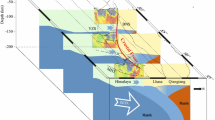Abstract
This paper presents lateral conductivity variations in the Earth's crust in and around the southern Korean Peninsula, which were mapped using magnetic field variations recorded at ten sites in Korea. GDS data can provide an efficient way to identify crustal units having different conductivities. And a three-dimensional (3-D) magnetotelluric (MT) modeling based on the induction arrows revealed a major conductivity anomaly in and around the Korean Peninsula. The comparison of observed and modeled induction arrows strongly suggests evidence of a relationship between main tectonic belts and the deep conductivity anomalies in this area. The overall pattern of induction arrows in this area appears to indicate a northwest-southeast direction, which is similar to that of the so-called ‘sea effect’, affected by the surrounding sea. However, the results of observations in the middle of the peninsula imply an anomalous pattern in the tectonic area near the Imjin River Belt. Induction arrows in the mid-southern area appear to be related to a thick sedimentary pile, the Ogcheon Belt, which forms another tectonic boundary in the Korean Peninsula. The overall pattern of arrows observed in the coastal area and islands was affected by the sea effect. The pattern, which shows southward arrows similar to those in the previous study of the southern coastline of the peninsula and Jeju Island near Kyushu, Japan, might indicate highly conductive anomalies (HCL) (Shimoizumi et al., 1997). However, the sea effect seems to be weak in the western coastal region, probably because the Yellow Sea is much shallower than the East Sea (Sea of Japan), and this phenomenon leads to the possibility of discerning an anomalous pattern beneath the Yellow Sea.
Similar content being viewed by others
References
Avdeev, D.B., Kuvshinov, A.V., Pankratov, O.V., Newman, G.A., 2000, 3-D EM modeling using fast integral equation approach with Krylov subspace accelerator. 62nd EAGE Conference & Technical exhibition. Abstract Vol., Glasgow, Scotland.
Bapat, V.J., Segawa, J., Honkura, Y., Tarits, P., 1993. Numerical estimations of the sea effect on the distribution of induction arrows in the Japanese island are. Phys. Earth Planet. Inter. 81, 215–229.
Chang, K.H., 1995. Aspects of geologic history of Korea (with English abstract), J. Geol. Soc. Korea, 31, 72–90.
Cho, M., Kwon, S.T., Ree, J.H., Nakamura, E., 1995, High-pressure amphibolite of the Imjingang belt in the Yeoncheon-Cheongok area (with English abstract), J. Petrol. Soc. Korea, 4, 1–19.
Chough, S.K., Kwon, S.T., Ree, J.H., Choi, D.K., 2000, Tectonic and sedimentary evolutions of the Korean peninsula: a review and new view. Earth Sci. Rev. 52, 175–235.
Chu, P.C., Lan, J., Fan, C., 2001. Japan Sea thermohaline structure and ciruclation. Part I: climatology. J. Phys. Oceanogr 31, 244–271.
Cluzel, D., 1992, Ordovician bimodal magmatism in the Ogcheon belt (South Korea): Intracontinental rift-related volcanic activity. J. Southeast Asian Earth Sci. 7, 195–209.
Cluzel, D., Cadet, J.-P., Lapierre, H., 1990, Geodynamics of the Ogcheon Belt (South Korea). Tectonophysics, 183, 41–56.
Dosso, H.W., Meng, Z.W., 1992, The coast effect responses in geomagnetic field measurements. Phys. Earth Planet. Inter. 70, 39–56.
Egbert, G.G., Booker, J.R., 1986, Robust estimation of geomagnetic transfer functions. Geophys. J. R. Astron. Soc. 87, 173–194.
Ernst, W.G., Liou, J.G., Hacker, B.R., 1994. Petrotectonic significance of high- and ultrahigh-pressure metamorphic belts: Inferences for subduction zone histories. Int. Geol. Rev. 36, 213–237.
Fan, G.H., Yao, T., Gu, Z., Zhu, K., Chen, P., Feng, J., 1997, The observation and interpretation of geomagnetic variations in a small area of Hainan Province. Acta Seismologica Sinica. 10, 329–337.
Fan, G.H., Hou, Z., Gu, Z., Zhu, K., Yao, T., 1993, Geomagnetic variation anomaly and deep electric conductivity structure in the area around Tangshan. Acta Seismologica Sinica. 6, 789–794.
Honkura, Y., 1974, Electrical conductivity anomalies beneath the Japan are. J. Geomagn. Geoelectr. 26, 147–171.
Kim, O.J., 1970, Geology and tectonics of the mid-central region of South Korea (with English abstract). J.K. Inst. Mining Geol. 2, 73–90.
Kobayashi, T., 1953, Geology of South Korea with special reference to the limestone plateau of Kogendo. The Cambro-Ordovician formations and faunas of South Chosen (Korea). J. Fac. Sci. Univ. Tokyo. 8, 145–293.
Liu, X., 1993, High-P metamorphic belt in central China and its possible eastward extension to Korea. J. Petrol. Soc. Korea. 2, 9–18.
Mackie, R.L., Smith, J.T., Madden, T.R., 1994, Three-dimensional electromagnetic modeling using finite difference equations: The magnetotelluric example. Radio Sci. 29, 923–935.
Min, K.D., 2001. Mantle diapir beneath the marginal sea between Korean Peninsula and Kyushu Island. 996-0400-001-2. Korea Science and Engineering Foundation.
Nakada, M., Yanagi, T., Maeda, S., 1997, Lower crustal erosion induced by mantle diapiric upwelling Earth Planet. Sci. Lett. 146, 415–429.
Reedman, A.J., Um, S.H., 1975, The geology of Korea. Geological and Mineral Institute of Korea, Seoul, Korea.
Rikitake, T., 1969, The undulation of an electrically conductive layer beneath the island of Japan. Tectonophysics. 7, 257–264.
Russian Academy of Sciences, 1992. Geological map of Korean peninsula and adjacent areas. 1:1,500,000. Moscow.
Shimoizumi, M., Mogi, T., Nakada, M., Yukutake, T., Handa, S., Tanaka, Y., Uchida, H., 1997, Electrical conductivity anomalies beneath the western sea of Kyushu, Japan. Geophys. Res. Lett. 24, 1551–1554.
Vasseur, G., Weidelt, P., 1977, Bimodal electromagnetic induction in non-uniform thin sheets with an application to the northern Pyrenean induction anomaly. Geophys. J. R. Astron. Soc. 49, 593–607.
Yang, J.M., Kwon, B.D., Lee, D.K., Youn, Y.H., 2005, Robust estimation of MT transfer function by BI (Bounded influence) and RMP (Rejection based on Median Power) techniques. Korean Soc. Geosystem Eng. 42, 419–436.
Yang, Z.J., 1992, New progress in the study of the Jiadong. Regional Geology of China. 1, 43–50.
Yin, A., Nie, S., 1993. An indentation model for the North and South China collision and the development of the Tan-Lu and Honam fault systems. Eastern Asia. Tectonics. 12, 801–813.
Author information
Authors and Affiliations
Corresponding author
Rights and permissions
About this article
Cite this article
Oh, S., Yang, JM., Lee, D.K. et al. Deep geoelectrical structure in and around the southern Korean Peninsula by GDS study. Geosci J 10, 479–490 (2006). https://doi.org/10.1007/BF02910441
Received:
Accepted:
Issue Date:
DOI: https://doi.org/10.1007/BF02910441



